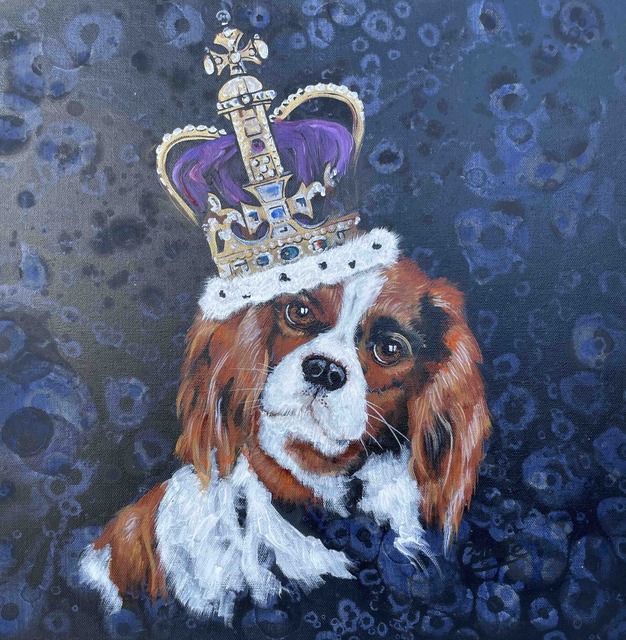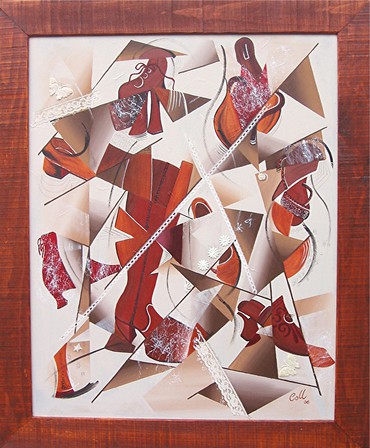The Truth About Mixing Acrylic And Oil Paint
As a New Zealand contemporary artist, I love experimenting with different materials and techniques to push the boundaries of my work. One of the most common questions I get asked is whether you can mix acrylic and oil paint.
Since I often incorporate mixed media into my paintings, including both oil and acrylic, I've spent years exploring the best ways to use these two very different paints together. Let's dive into what works, what doesn't, and how you can successfully combine acrylics and oils in your own art.
Understanding the Differences Between Acrylic and Oil Paint
So can you mix Acrylic and oil paint? Before mixing your paint, it's important to understand the unique properties of each type of medium and how they behave:
Acrylic Paint
Acrylic paint is a water-based, fast-drying paint and becomes flexible like a plastic wrap when dry. It adheres well to most surfaces and can be diluted with water, which allows for quick layering due to its rapid drying time.
And because of its versatility, acrylics are outstanding for creating bold, vibrant colours as well as textural effects. On top of this, artists can use acrylic mediums such as Golden's Glazing liquid (my personal favourite) to modify the finish, extend the drying times, or add to create texture.
Oil Paint
Oil paint is made with pigment suspended in an oil-based binder, typically linseed oil. It dries slowly, allowing for extended blending time, smooth transitions, and adds deeper, more luminous colours.
However, traditional oil paints require the use of solvents like turpentine or linseed oil for thinning and cleaning, which can make them messier and much more time-consuming to work with compared to wter based acrylic paints.
The slow drying time of oils means that layers remain workable for long periods, making them ideal for detailed blending and glazing techniques. My bugbear with oils, when I solely worked with them, was drying time in winter; they always seemed to take forever, slowing down my productivity and ability to get artwork to the framers to prepare for sale.
King Charles pet portrait by Collette Fergus
Water-Mixable Oil Paints – A Modern Alternative
In recent years, there has been a new type of oil paint that has emerged: water-mixable (or water-soluble) oil paints by Windsor & Newton, which I actually gave a go. These paints are designed to behave like traditional oils but can be thinned and cleaned with water instead of needing to use harsh solvents.
The key difference lies in their modified oil binder, which allows them to mix with water while still maintaining the slow drying time and rich texture of traditional oils (I know it sounds just like acrylic paint right!). This makes them a fantastic option for artists who want the benefits of oil paint without the strong fumes or any need for chemical solvents.
If they had been available when I made the switch from oils I'd most likely have gone with these rather than acrylic.
While water-mixable oils can be blended with traditional oils and oil-based mediums, they should not be mixed directly with acrylics, as they are still fundamentally oil-based. However, they can be used successfully in combination with acrylics if layered correctly, applying them over a dried acrylic base, just like you do with traditional oils.

Why Mixing Acrylic and Oil is Tricky
Because acrylics dry quickly and form a flexible, plastic-like film, while oils remain soft and take much longer to cure, they behave very differently. This difference in drying times and chemical composition makes direct mixing problematic, leading to issues such as poor adhesion, cracking, or separation.
Understanding these differences helps in finding the best ways to use them together in a painting while avoiding common pitfalls.
The Dos of Mixing Acrylic and Oil Paint
While traditional painting techniques warn against directly mixing acrylic and oil, I've found several ways to use them together effectively:
Use Acrylic as an Underpainting
One of my favourite techniques is starting a painting with an acrylic underpainting. Since acrylic dries quickly, it allows me to establish the composition and basic colour values before layering oil paint on top for added depth and richness.
Follow the 'Fat Over Lean' Rule
One of the most crucial rules in painting is the 'Fat Over Lean' principle. Understanding this rule gives you a sense of control and confidence in your process. Remember, oil paint takes longer to dry than acrylic, so always apply oil over acrylic, never the other way around.
What is the fat over lean rule?
The "fat over lean" rule means you should paint oily (fat) layers of paint over layers with less oil (lean) when using oil paints. This helps the paint stick properly, dry at the right speed, and look nice and glossy. It's an important technique for making sure your painting lasts and looks good.
This knowledge ensures that your layers will adhere properly and your artwork will stand the test of time.
Experiment with Acrylic and Oil Mediums
I love using acrylic gel mediums to create texture in the early layers of a painting. Later, I enhance those textures with oil glazes, which adds depth and a luminous quality that acrylics alone can't achieve.
The Don'ts of Mixing Acrylic and Oil Paint
Don't Mix Acrylic and Oil Paint on a Palette
Since one is water-based and the other is oil-based, they simply don't mix. If you attempt to blend them together on a palette, you'll quickly notice that instead of a smooth, creamy consistency, the paint will separate, curdle, or form an unusable mess.
Imagine trying to mix oil and vinegar in a salad dressing without an emulsifier, the two components stubbornly resist each other, creating a patchy, unworkable result.
I once tried this myself in the early days of my painting journey, thinking I could create a unique hybrid texture. Instead, I ended up with strange clumps of oily pigment sitting awkwardly in pools of watery acrylic.
No matter how much I mixed, the paint refused to blend properly, leaving me with a wasted palette of unusable paint.
Don't Apply Acrylic Over Oil Paint
One mistake I've learned to avoid is applying acrylic over oil. This cautionary tale is a reminder to always respect the properties of each paint. Because oil paint dries slowly and remains flexible for a long time, whereas acrylic dries quickly and becomes rigid, applying acrylic over oil can lead to disaster.
The result is a damaged, patchy painting that could have been avoided with this knowledge.
Picture this: You've just finished an oil painting, but you decide that one area needs a little extra vibrancy, so you grab your acrylics and start layering. It looks fine at first, but a few months later, you notice fine cracks appearing across the surface.
Eventually, the acrylic layer begins to flake away, leaving a damaged, patchy painting. It's frustrating and irreversible, so it's always best to avoid this mistake from the start.
Don't Use Water to Thin Oil Paint
While acrylics can be thinned easily with water, oil paints require special solvents like turpentine or linseed oil to maintain their consistency and adhesion. Adding water to oil paint will cause it to bead up and separate rather than blend smoothly, ruining the integrity of the paint.
Imagine dipping a brush loaded with oil paint into water, expecting it to thin out like an acrylic wash. Instead, the pigment breaks apart into uneven streaks, forming an unpredictable and blotchy application.
It's like trying to mix butter with water, it just won't work correctly. If you want to create thinner, more translucent oil layers, always use an appropriate medium designed for oil paints.
"Those Old Brown Shoes," Oil and Acrylic Artwork by Collette
How I Successfully Combine Acrylic and Oil in My Work
If you want to use both media in a single artwork, here are some techniques I use:
- Layering: I start with an acrylic base and then layer oil paint or oil paint glazes over the top for richer colour and depth.
- Textural Effects: I use acrylic mediums to create raised textures and then enhance them with oil glazes.
- Separate Sections: Sometimes, I use acrylic for bold, flat areas and oils for softer, blended transitions within the same piece.
Final Thoughts
While mixing acrylic and oil directly isn't ideal, you can absolutely use both in the same painting by layering correctly. I've found that using acrylics for the foundation and then finishing with oil allows for greater versatility and richer results.
If you're looking to experiment, start small, play with textures, and see how these two mediums can enhance your artistic expression.
Posted: Sunday 6 April 2025


